Vibrant Breakfasts Around the World.
Breakfast is more than just the first meal of the day it’s a cultural ritual, a time for families to come together, and an opportunity to savor flavors that tell the story of a region’s history and traditions. From the bustling streets of Marrakech to the sun-kissed coastlines of California, and the vibrant neighborhoods of Istanbul, breakfast plays a vital role in shaping the identity of these diverse cultures.
In this journey, we’ll explore the vibrant breakfasts of Morocco, Turkey, and the USA three countries where breakfast is not just food, but a celebration of local flavors, hospitality, and community. Whether it’s the comforting warmth of Moroccan mint tea, the hearty spread of a traditional Turkish breakfast, or the iconic American pancakes, each meal offers a unique glimpse into the heart of its culture.
Join us as we uncover the stories behind these morning meals, filled with rich ingredients, bold flavors, and centuries-old traditions. From the sweet and savory tastes of Morocco to the diverse regional breakfasts of the United States, and the wholesome, family-style mornings of Turkey these vibrant breakfasts await your discovery. So, pull up a chair and get ready to savor a global breakfast adventure!
Why Breakfast Traditions Are So Important
Breakfast traditional meals go beyond food; they symbolize hospitality, health, and even history. Each of these breakfasts offers a special insight into local life. In Morocco, breakfast is about warmth and richness; in America, it’s often a quick yet satisfying meal; in Turkey, it’s a chance to connect with family and friends. Each style has something unique to offer, making breakfast traditional an enjoyable and meaningful way to start the day.
Table of Contents
Moroccan Breakfast: A Flavorful Feast
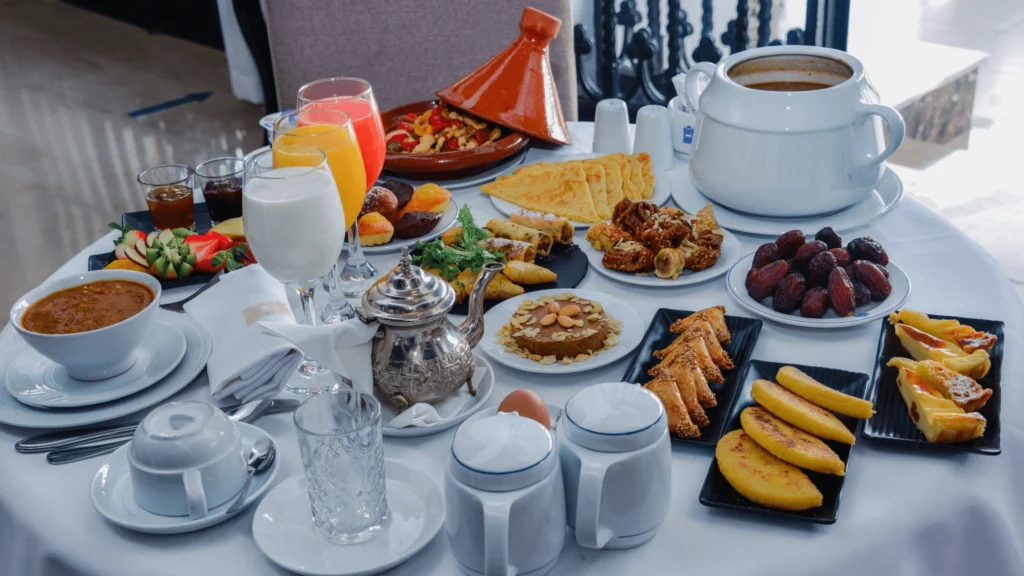
Moroccan Breakfasts: A Flavorful Start to the Day
Traditional Moroccan Breakfast Dishes
Morocco’s breakfast table is a testament to its rich culinary heritage, blending bold flavors, intricate preparations, and comforting staples. Here’s a closer look at some key components:
Msemen (Moroccan Flatbread)
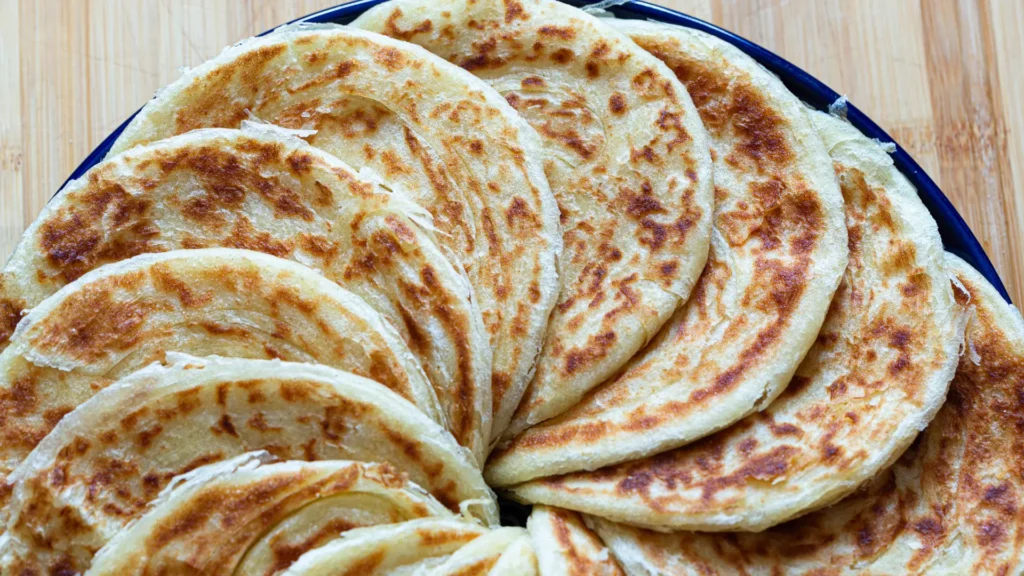
Msemen is a beloved Moroccan breakfast staple, often referred to as the country’s take on a flaky pancake or flatbread. This square-shaped delicacy is made from a simple dough of flour, semolina, water, and a pinch of salt. The dough is folded multiple times, brushed with oil or butter during each fold, creating a crisp and flaky texture when cooked on a griddle.
Msemen is versatile served either sweet or savory. It’s commonly drizzled with honey or paired with jam for a sweet start to the day, or accompanied by creamy cheese and olives for a savory twist. Found in Moroccan households and street stalls alike, Msemen perfectly captures the essence of a comforting morning meal.
Briouat (Savory Pastries)

Briouat, triangular or crescent-shaped pastries, are another star of the Moroccan breakfast spread. Made with thin sheets of warqa dough (similar to phyllo), these pastries are often stuffed with a variety of fillings such as cheese, minced meat, or spiced vegetables. The fillings are seasoned with Moroccan spices like cinnamon, cumin, and saffron, delivering a flavorful bite.
Once filled, Briouats are folded into neat shapes, fried to golden perfection, and sometimes finished with a drizzle of honey for a subtle sweetness. These savory pastries pair wonderfully with Moroccan mint tea, making them a common choice for a leisurely breakfast.
Harira (Moroccan Porridge)

While Harira is traditionally known as a hearty soup consumed during Ramadan, its simpler porridge-like version is a warming breakfast choice, especially in colder months. This dish often features a base of lentils, chickpeas, or barley, enriched with spices like turmeric, ginger, and cinnamon for a fragrant and flavorful profile.
Served piping hot, Harira provides a nourishing start to the day. It’s particularly popular in rural areas, where hearty breakfasts fuel the day’s work. Many Moroccan families enjoy this dish with a piece of crusty bread or flatbread for dipping, creating a wholesome and satisfying meal.
Iconic Moroccan Beverages
Moroccan breakfasts are incomplete without the inclusion of their iconic beverages, which are deeply rooted in the country’s culture and hospitality. Two staples stand out as the perfect complements to any Moroccan morning spread:
Mint Tea: The Role of Mint Tea in Moroccan Hospitality
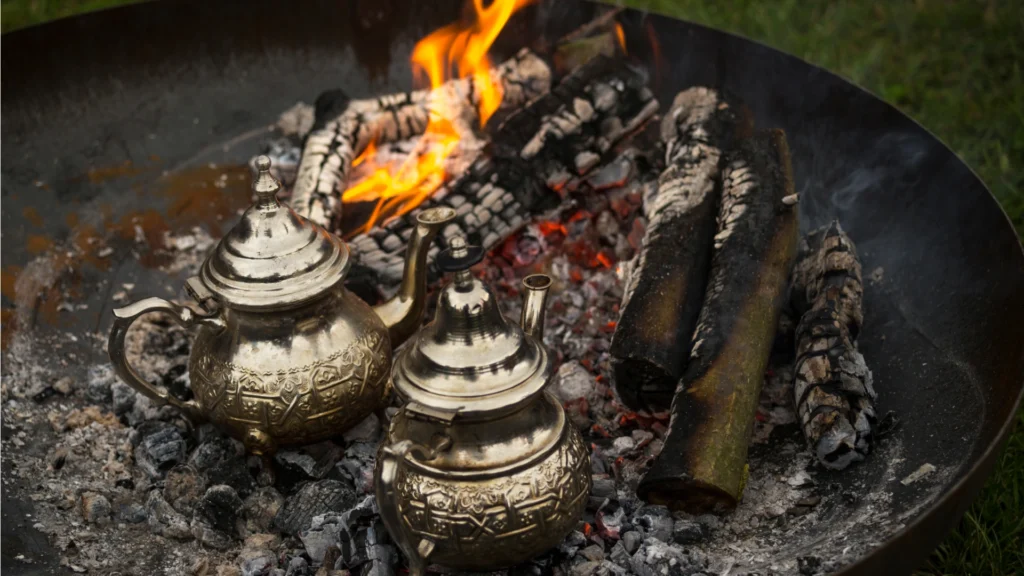
Known as “atay b’nana,” Moroccan mint tea is much more than a morning drink it’s a symbol of warmth, hospitality, and tradition. This beloved beverage is prepared with a blend of green tea leaves, fresh mint sprigs, and generous amounts of sugar, brewed together to create a sweet and aromatic infusion.
The preparation of mint tea is an art form in Morocco, often involving an elaborate pouring ritual. The tea is poured from a height, creating a frothy top layer that enhances the drinking experience. This technique is as much about aerating the tea as it is a visual representation of Moroccan culture.
Mint tea is served throughout the day but holds a special place at breakfast, where it pairs beautifully with Msemen, Briouat, and other sweet or savory dishes. Beyond its flavor, the act of sharing mint tea signifies respect and friendship, making it a cornerstone of Moroccan hospitality.
Moroccan Coffee: The Differences Between Traditional Moroccan Coffee and Western Styles
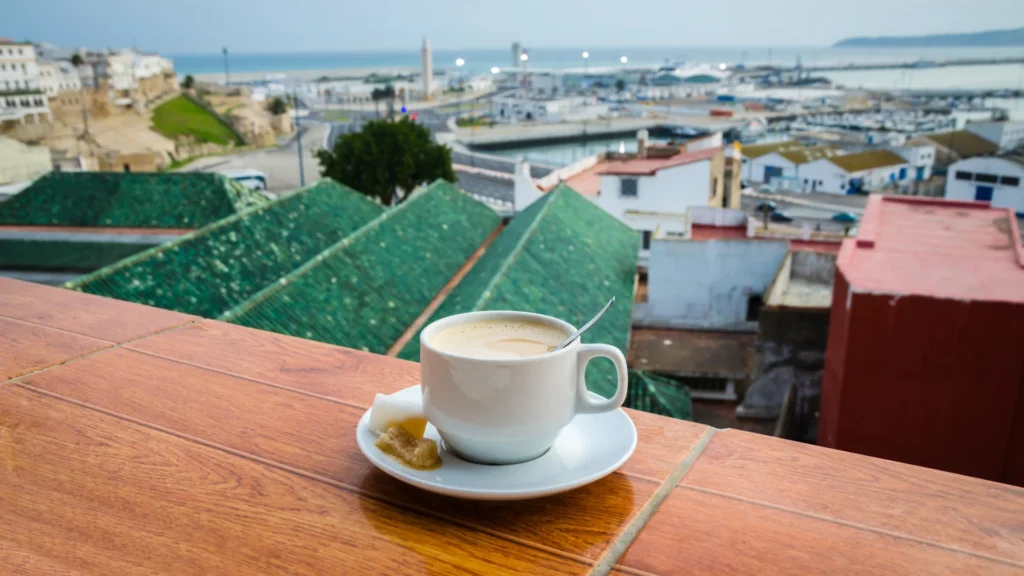
Moroccan coffee, or “qahwa,” offers a distinctly local twist on this global beverage. Unlike the bold, often dark roasts of Western coffee, Moroccan coffee is typically infused with a delicate blend of spices such as cardamom, cinnamon, or nutmeg. This spiced coffee is aromatic, warming, and uniquely Moroccan.
The preparation often involves boiling finely ground coffee with the spices in water, resulting in a fragrant brew. In urban areas, espresso-style coffee is also popular, served in small cups similar to European traditions but sometimes enhanced with a touch of sugar or spices.
Coffee in Morocco is enjoyed in intimate settings, whether at home or in bustling cafes. It serves as a moment to relax and connect, reflecting the slower, communal approach to meals that defines Moroccan culture.
Cultural Significance of Moroccan Breakfast
In Morocco, breakfast is more than just a meal it’s a cherished daily ritual that embodies the values of community, tradition, and nourishment. The cultural significance of the Moroccan breakfast extends far beyond the food itself.
Family Gatherings: The Communal Experience of Sharing Meals
Moroccan breakfast is a time for connection, where families come together to share a meal before embarking on their daily routines. The dining table, or often a low communal table, becomes a hub of interaction, filled with conversations, laughter, and stories.
This tradition is particularly strong in rural areas, where multi-generational households gather to enjoy a homemade spread. Everyone contributes to preparing the breakfast, whether kneading dough for Msemen, brewing mint tea, or setting the table with an array of small plates.
The act of sharing food symbolizes unity and generosity, two pillars of Moroccan culture. Guests are always welcomed with an abundance of food, embodying the deep-rooted hospitality for which Morocco is renowned.
The Importance of Starting the Day with a Healthy and Hearty Meal
A Moroccan breakfast is designed to nourish both the body and soul, providing energy for the day ahead. The emphasis on natural, wholesome ingredients such as fresh bread, olive oil, honey, and seasonal fruits reflects the importance of a balanced diet.
Traditional dishes like Msemen and Harira offer a blend of carbohydrates, protein, and fats, ensuring a sustained source of energy. Accompaniments like olives and dates not only add bursts of flavor but also contribute to a nutrient-rich meal.
Beyond the physical nourishment, the act of starting the day with a thoughtfully prepared breakfast reflects the Moroccan way of life taking time to enjoy simple
American Breakfasts: A Diverse and Hearty Tradition

Classic American Breakfast Foods
The American breakfast is a hearty and satisfying affair that has become iconic worldwide. From fluffy pancakes to savory egg dishes, each breakfast staple reflects the diversity and abundance of American cuisine.
Pancakes and Waffles: Sweet, Fluffy Classics

Few breakfast dishes are as quintessentially American as pancakes and waffles. Pancakes are typically made with a simple batter of flour, milk, eggs, and baking powder, cooked until golden, and topped with a drizzle of maple syrup, butter, or seasonal fruits.
Waffles, with their crisp, golden exterior and soft interior, are made using a waffle iron that creates their signature grid pattern. Both pancakes and waffles are often served with a side of bacon or sausage for a sweet-and-savory combination that appeals to all ages.
These dishes have regional variations as well for example, blueberry pancakes in New England or pecan waffles in the South. They are also popular in diners across the country, reinforcing their status as a classic morning indulgence.
Eggs Benedict: The Elegant Brunch Staple

Eggs Benedict is a sophisticated breakfast dish that has become a brunch favorite in the United States. It consists of a toasted English muffin topped with Canadian bacon or smoked salmon, a poached egg, and a generous ladle of hollandaise sauce—a rich, creamy sauce made from egg yolks, butter, and lemon juice.
This dish is often paired with a side of fresh greens or hash browns, offering a luxurious start to the day. Eggs Benedict is synonymous with weekend brunch culture, frequently served at upscale cafes and restaurants.
Bagels with Cream Cheese: A New York Classic

Bagels, originally brought to the U.S. by Eastern European immigrants, have become a defining feature of American breakfast, especially in cities like New York. These chewy, ring-shaped breads are boiled before baking, giving them their signature texture.
Bagels are often topped with cream cheese and paired with smoked salmon (lox), capers, and red onions for a sophisticated yet simple dish. Variants include everything bagels, sesame bagels, and cinnamon raisin bagels, catering to both savory and sweet preferences.
Hearty Sides: Bacon, Sausage, and Hash Browns
No classic American breakfast is complete without its sides. Crispy bacon and savory breakfast sausages are iconic accompaniments, adding protein and a smoky flavor to the meal.
Hash browns, made from grated potatoes that are pan-fried until crispy, are another staple. Their crunchy exterior and tender interior make them a comforting and versatile side dish.
Regional Variations of Breakfast in the USA
The United States is a melting pot of cultures, and its breakfast offerings reflect the diverse influences of its regions. From the hearty, comforting dishes of the South to the health-conscious options of the West Coast, American breakfasts vary widely across the country, showcasing local flavors and culinary traditions.
Southern Breakfast: Comfort on a Plate
In the South, breakfast is a hearty and flavorful affair, often described as “comfort food at its best.” Staples include:
- Biscuits and Gravy: Fluffy, buttery biscuits smothered in creamy sausage gravy, a dish rooted in Southern hospitality.
- Grits: A warm, creamy porridge made from ground corn, often served with butter, cheese, or shrimp.
- Chicken and Waffles: A unique sweet-and-savory combination of crispy fried chicken and fluffy waffles, topped with maple syrup.
The Southern breakfast is not just about the food it’s about starting the day with a meal that feels like a hug from home.
West Coast Influences: Fresh, Health-Conscious Choices
The West Coast is known for its innovative and health-focused breakfast options, often incorporating fresh, local ingredients. Popular dishes include:
- Avocado Toast: Toasted artisanal bread topped with mashed avocado, sprinkled with chili flakes, olive oil, and sometimes a poached egg.
- Acai Bowls: A vibrant blend of acai berries topped with granola, fresh fruit, and honey, reflecting California’s wellness culture.
- Breakfast Burritos: Inspired by Mexican cuisine, these wraps are filled with scrambled eggs, cheese, potatoes, and often salsa or guacamole.
West Coast breakfasts emphasize light, nutritious meals that fuel an active lifestyle.
Northeastern Breakfasts: A Taste of Tradition
The Northeast, particularly New York and New England, is famous for its simple yet satisfying morning fare. Highlights include:
- Bagels with Lox and Cream Cheese: A New York staple, often accompanied by capers, onions, and fresh dill.
- Boston Baked Beans with Brown Bread: A hearty, historic breakfast that reflects New England’s colonial roots.
- Apple Cider Donuts: A seasonal favorite in fall, showcasing the region’s apple orchards.
These breakfasts often have a rustic charm, with recipes passed down through generations.
Midwestern Breakfasts: Hearty and Farm-Fresh
In the Midwest, breakfast is often farm-inspired, emphasizing hearty and filling dishes. Popular items include:
- Casseroles: Egg-based breakfast casseroles with cheese, sausage, and vegetables are a Midwestern brunch staple.
- Pancakes with Maple Syrup: Reflecting the region’s maple syrup production, particularly in states like Wisconsin and Michigan.
- Kolaches: A pastry with fruit or cheese filling, brought by Czech immigrants and popular in states like Texas.
Midwestern breakfasts are designed to provide sustenance for a day of hard work, reflecting the agricultural heritage of the region.
Southwestern Flavors: A Spicy Kick to the Morning
The Southwest incorporates bold, spicy flavors into its breakfast dishes, influenced by Mexican and Native American cuisines. Standouts include:
- Huevos Rancheros: A classic dish of fried eggs served on tortillas with salsa, beans, and avocado.
- Chilaquiles: Tortilla chips simmered in red or green salsa, topped with eggs, cheese, and crema.
- Green Chile Breakfast Burritos: Packed with eggs, potatoes, cheese, and New Mexico’s famous green chile sauce.
These breakfasts are a celebration of the region’s vibrant culinary heritage and love for spice.
The American Breakfast Experience
Breakfast in the United States is more than just a meal it’s a cultural institution. Rooted in traditions, shaped by regional diversity, and evolving with modern trends, the American breakfast experience encapsulates both nostalgia and innovation. It’s a time for families to gather, for friends to brunch, and for individuals to indulge in their favorite comfort foods.
The Rise of Brunch Culture
In recent decades, brunch has become a quintessential part of the American dining experience, especially in urban centers. This late-morning to early-afternoon meal blends breakfast and lunch, often accompanied by beverages like coffee, mimosas, or Bloody Marys (minus the alcohol for mocktail lovers). Key aspects of brunch culture include:
- Social Connections: Brunch is often a social event, a time to catch up with friends or celebrate special occasions.
- Creative Menus: Restaurants and cafes experiment with unique dishes, such as red velvet pancakes or eggs benedict with lobster.
- Weekend Rituals: For many, brunch has become a cherished weekend tradition, signaling relaxation and indulgence.
Breakfast as a Family Tradition
For American families, breakfast often serves as a time to bond before the day begins. In homes across the country, it’s common to see:
- Weekend Pancake Mornings: Parents flipping pancakes on Saturday mornings, often topped with butter and syrup.
- Cereal and Milk: A quick and easy weekday staple, particularly for school-aged children.
- Holiday Breakfast Feasts: Special occasions like Christmas or Thanksgiving mornings feature elaborate spreads, including casseroles, muffins, and fruit salads.
These shared moments create lifelong memories and traditions passed from one generation to the next.
The Role of Diners in American Breakfast Culture
Diners are iconic to American breakfast culture, offering an affordable and nostalgic setting for early-morning meals. Characteristics of the diner experience include:
- All-Day Breakfast: Many diners serve breakfast 24/7, making it possible to enjoy pancakes or omelets at any hour.
- Hearty Portions: From towering stacks of pancakes to oversized breakfast platters, diners are known for generous servings.
- Community Hubs: Diners often serve as gathering places, where locals catch up over coffee and hash browns.
The classic image of a diner with its neon signs, booths, and sizzling griddle is deeply ingrained in American pop culture.
Balancing Tradition and Modernity
While traditional breakfasts like eggs, bacon, and toast remain staples, modern trends are reshaping the American breakfast experience. These include:
- Health-Conscious Choices: Many Americans are opting for nutrient-dense options such as Greek yogurt, smoothies, or oatmeal with superfoods like chia seeds and berries.
- Plant-Based Options: With the rise of vegetarian and vegan diets, plant-based breakfast items like tofu scrambles and vegan pancakes have gained popularity.
- On-the-Go Meals: In today’s fast-paced world, grab-and-go breakfasts like breakfast sandwiches, protein bars, and pre-packaged parfaits are increasingly common.
The American breakfast experience continues to evolve, blending tradition with innovation while remaining a cherished part of daily life.
Turkish Breakfasts: A Wholesome Morning Feast
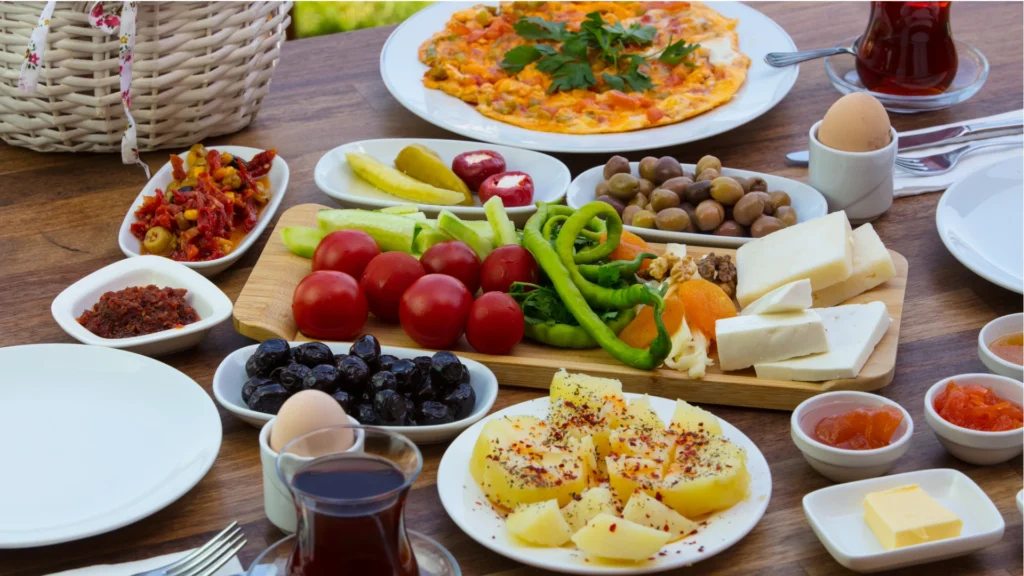
Iconic Turkish Breakfast Dishes
Turkish breakfast, known as kahvaltı, is a feast for the senses, characterized by an assortment of small dishes and vibrant flavors that emphasize variety and freshness. A traditional Turkish breakfast often becomes a social event, perfect for savoring leisurely over tea and good conversation. Here are some of the most iconic dishes that make this morning meal unforgettable:
1. Simit (Turkish Sesame Bagel)

A beloved breakfast staple, simit is a circular bread encrusted with sesame seeds, offering a crisp exterior and soft, chewy interior. Often paired with cheeses, olives, and jams, simit is the ultimate grab-and-go breakfast but also finds its place on elaborate breakfast tables. Its rich sesame flavor and satisfying texture make it a Turkish classic.
2. Menemen (Turkish Scrambled Eggs with Vegetables)
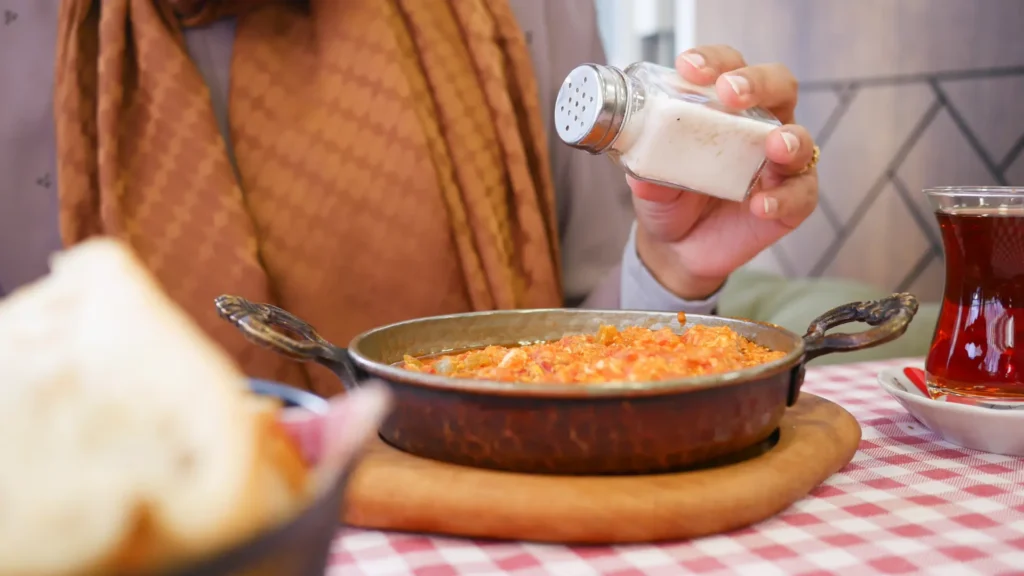
This flavorful dish consists of scrambled eggs cooked with tomatoes, green peppers, and a mix of fragrant spices. Sometimes enriched with cheese or sucuk (Turkish sausage), menemen is a versatile dish that perfectly complements fresh bread. Its warm, savory profile adds heartiness to the breakfast spread.
3. Borek (Savory Pastry)

Borek is a flaky pastry made from thin layers of yufka (similar to phyllo dough), often filled with cheese, spinach, or ground meat. Its crisp, golden-brown exterior and rich, flavorful fillings make it a favorite breakfast item, typically served warm with a side of tea.
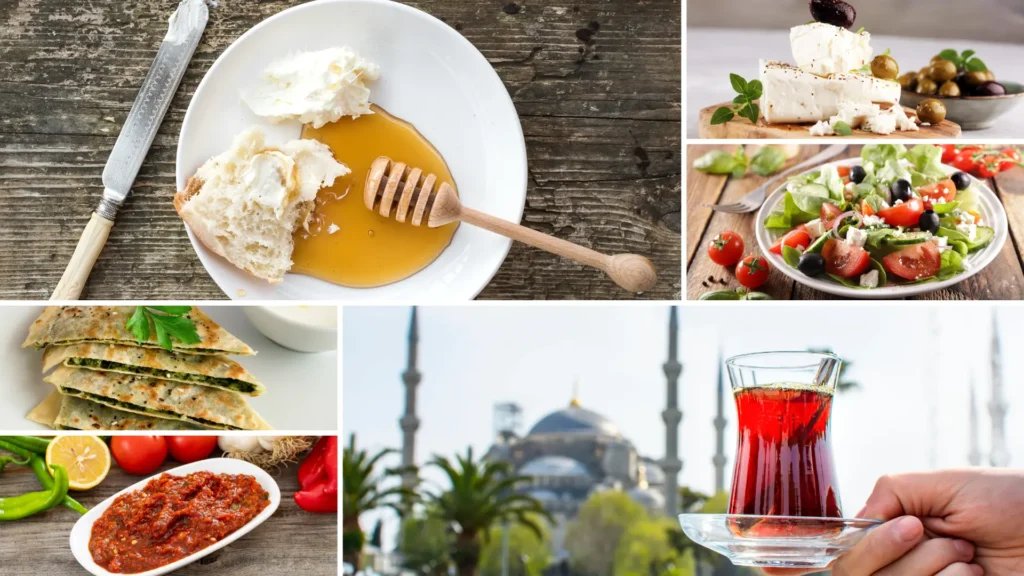
. Kaymak and Honey
A quintessential Turkish breakfast treat, kaymak (clotted cream) is luxuriously creamy and pairs beautifully with golden honey. Served on fresh bread or as a standalone indulgence, this combination is a delightful way to satisfy morning sweet cravings.
. Olives and Cheese
Turkish breakfast is incomplete without an array of olives and cheeses. Black and green olives, often marinated with lemon and spices, add a briny, tangy contrast to the meal. Cheese varieties such as beyaz peynir (white cheese), kaşar (yellow cheese), and tulum (aged goat cheese) offer a diverse range of textures and flavors.
. Cucumber and Tomato Salad
Freshly sliced cucumbers and tomatoes are essential for a balanced breakfast. Dressed with olive oil and a sprinkle of salt, this simple yet refreshing salad adds brightness and complements the richer elements of the meal.
. Gözleme (Stuffed Flatbread)
Gözleme is a hand-rolled flatbread filled with ingredients such as spinach, feta cheese, or minced meat, then cooked on a griddle. This warm, savory dish is a breakfast favorite for its comforting flavors and satisfying texture.
. Acuka (Spicy Spread)
A tangy and spicy spread made from walnuts, red peppers, tomato paste, and olive oil, acuka is typically smeared on bread and enjoyed alongside other breakfast items. Its bold flavor adds a zesty kick to the meal.
. Turkish Tea (Çay)
No Turkish breakfast is complete without endless glasses of çay. Served in tulip-shaped glasses, this strong, aromatic black tea is the perfect beverage to accompany the variety of dishes on the table.
. Jams and Marmalades
Homemade jams and marmalades, made from fruits such as figs, apricots, and cherries, add sweetness and color to the breakfast spread. Spread on bread or enjoyed with kaymak, they offer a delightful contrast to the savory items.
Turkish breakfast is more than just a meal; it’s an experience that celebrates the rich culinary heritage of Turkey, emphasizing shared moments, bold flavors, and the joy of starting the day with a feast.
The Role of Tea and Coffee in Turkish Breakfast
Tea and coffee hold a special place in Turkish breakfast culture, often acting as the unifying elements that bring the diverse flavors of the meal together. While food takes center stage, tea and coffee serve as the perfect accompaniments, enhancing the overall experience and adding warmth to the communal atmosphere.
Turkish Tea (Çay): The Essential Breakfast Beverage
Turkish tea, or çay, is an indispensable part of any breakfast in Turkey. Served in iconic tulip-shaped glasses, its deep red color and robust flavor make it the perfect complement to the array of savory and sweet dishes. The tea is brewed in a two-tier teapot (çaydanlık), where the top pot holds concentrated tea while the bottom contains hot water to dilute it to the drinker’s preference.
Drinking tea is more than just a habit; it’s a ritual deeply rooted in Turkish hospitality and culture. A steaming glass of tea is always present, whether you’re enjoying a quick breakfast or a long, leisurely weekend meal with friends and family. It acts as a palate cleanser between bites, balancing the rich flavors of cheese, olives, and pastries, and creating moments of pause and conversation.
Turkish Coffee: A Post-Breakfast Delight
While tea dominates during breakfast, Turkish coffee (Türk kahvesi) often makes its appearance afterward as a leisurely conclusion to the meal. Made using finely ground coffee beans and prepared in a small copper pot called a cezve, Turkish coffee is rich, strong, and aromatic. It is typically served in small porcelain cups alongside a glass of water to cleanse the palate.
Unlike Western coffee, Turkish coffee is not filtered, leaving a layer of ground at the bottom of the cup. This has led to the tradition of fortune-telling (fal), where the leftover grounds are read to predict one’s future a delightful cultural twist often enjoyed after a hearty breakfast.
The Social Aspect of Tea and Coffee
Both tea and coffee are deeply ingrained in Turkish social traditions. The act of pouring tea for others or brewing coffee with care reflects the spirit of hospitality that Turkish culture is known for. Breakfast is often seen as an opportunity to connect with loved ones, and tea and coffee play a vital role in facilitating these meaningful interactions.
Whether it’s the invigorating aroma of freshly brewed tea or the bold taste of Turkish coffee, these beverages do more than just quench thirst they enhance the sensory and social aspects of breakfast, turning it into a cherished daily ritual.
Turkish Breakfast as a Social Experience
In Turkey, breakfast is much more than a meal it’s a cherished social ritual that fosters connection, conversation, and a sense of community. Known as kahvaltı, which translates to “before coffee,” breakfast is often the most elaborate and communal meal of the day, especially on weekends.
A Tradition of Togetherness
Turkish breakfast is a shared experience that brings family and friends together around a beautifully arranged table filled with a variety of small dishes. Unlike the fast-paced breakfasts common in some cultures, kahvaltı is meant to be enjoyed at a leisurely pace, allowing for meaningful conversations and quality time.
Weekday breakfasts may be quick and functional, but weekend breakfasts in Turkey are a special occasion. Families gather for hours, chatting, laughing, and savoring an array of flavors. It’s a time to slow down, reconnect, and enjoy the company of loved ones, with the food serving as a centerpiece for these interactions.
A Table Meant for Sharing
The Turkish breakfast table is a feast for the senses, typically brimming with an assortment of fresh, colorful dishes that are shared communally. From savory staples like cheeses, olives, and eggs to sweet treats like jams and kaymak (clotted cream with honey), every dish is placed at the center of the table, encouraging everyone to participate in the meal.
Bread, often freshly baked and served warm, acts as the foundation of the meal, used to scoop up dips, spread toppings, or pair with cheese and honey. This style of eating creates a sense of closeness, as everyone reaches across the table, passing plates and sharing favorite bites.
Hospitality and Generosity
Turkish culture is renowned for its hospitality, and breakfast is one of the most prominent ways this hospitality is expressed. Guests are always welcomed with a lavish spread, and hosts often take great care to prepare a diverse selection of dishes to cater to everyone’s tastes.
Offering more food than one could possibly eat is a hallmark of Turkish hospitality. It’s not uncommon for the host to encourage guests to eat more, ensuring they feel well-fed and cared for. This generous spirit reinforces the communal and welcoming nature of Turkish breakfast.
Tea and Conversations
The constant flow of Turkish tea (çay) adds to the relaxed and social atmosphere of breakfast. Glasses are continuously refilled, providing opportunities for guests to linger longer at the table. The act of pouring tea for one another further emphasizes the communal bond and the importance of nurturing relationships.
Conversations flow just as freely as the tea. Discussions range from lighthearted topics to deeper reflections, making breakfast a time for both laughter and connection. Whether it’s catching up on family news or debating current events, the breakfast table becomes a space for dialogue and togetherness.
A Celebration of Culture and Community
Turkish breakfast embodies the values of generosity, community, and tradition. It’s a celebration of food, family, and friendship, where the focus isn’t just on eating but on creating memories and strengthening bonds. This communal experience is one of the reasons why Turkish breakfast holds such a special place in the hearts of both locals and visitors.
In Turkey, breakfast isn’t just about starting the day nit’s about sharing the moment. The combination of delicious food, heartfelt hospitality, and meaningful interactions makes it a truly unforgettable experience.
Breakfasts Around the World: Shared Traditions and Unique Flavors
The Importance of Breakfast in Different Cultures
Breakfast is often referred to as the most important meal of the day, and this sentiment transcends borders and cultures. Across the globe, breakfast is not just a meal but a reflection of cultural values, traditions, and lifestyles. From fueling the body for the day ahead to providing opportunities for social connection, breakfast serves many roles, varying widely depending on the culture.
A Universal Start to the Day
Despite regional differences in breakfast choices, there’s a common understanding that breakfast sets the tone for the day. In many cultures, breakfast is designed to provide energy, nourishment, and focus, with foods tailored to the local environment and available ingredients.
For instance, in agricultural societies, breakfast often consists of hearty and calorie-dense meals to sustain physical labor. In contrast, urban cultures may prioritize lighter breakfasts due to fast-paced lifestyles.
Cultural Reflections Through Food
Breakfast is a window into a culture’s culinary identity, showcasing ingredients, preparation techniques, and traditions unique to each region:
- Morocco 🇲🇦: Breakfast often features msemen (flatbread), briouat (savory pastries), and mint tea, emphasizing the use of fresh, local ingredients and the importance of starting the day with a social ritual.
- Japan 🇯🇵: A traditional Japanese breakfast is a well-balanced meal, including rice, miso soup, grilled fish, and pickled vegetables, reflecting the cultural emphasis on harmony, simplicity, and health.
- USA 🇺🇸: The classic American breakfast of eggs, bacon, and toast reflects the country’s abundance and preference for convenience, while regional variations—like Southern grits or Tex-Mex breakfast tacos highlight the diversity within the culture.
- India 🇮🇳: Breakfasts vary widely by region, from idli and dosa in the South to parathas in the North, emphasizing the nation’s rich culinary diversity and the importance of spices and flavors even in the first meal of the day.
Social and Communal Aspects
In many cultures, breakfast is a time for family and community:
- Turkey 🇹🇷: Breakfast (kahvaltı) is a leisurely, social experience. Shared plates of olives, cheeses, and jams encourage togetherness and conversation, particularly on weekends.
- Mexico 🇲🇽: Breakfast is often a communal affair, with dishes like chilaquiles or huevos rancheros prepared for the entire family to enjoy together.
- Ethiopia 🇪🇹: Breakfast might feature fit-fit or genfo, often shared with family, reflecting the communal dining culture deeply ingrained in Ethiopian society.
This communal aspect reinforces the idea that breakfast is not just about sustenance but about relationships and connection.
Health and Well-being
Breakfast’s role in health varies by culture but is universally seen as crucial for starting the day.
- In Western countries, there’s an emphasis on nutrient-packed breakfasts to support productivity and concentration. Smoothies, oatmeal, and eggs are common examples of this trend.
- In Asian cultures, breakfast often includes easily digestible foods like rice and soups, designed to nourish the body gently after fasting overnight.
- In Mediterranean cultures, breakfast incorporates fresh fruits, yogurt, and bread, aligning with the region’s reputation for heart-healthy diets.
Religious and Festive Significance
Breakfast in many cultures carries spiritual or festive importance. During Ramadan in Islamic cultures, suhoor (the pre-dawn meal) holds deep religious significance, serving as an act of worship and preparation for the day’s fast. Similarly, breakfast traditions during festivals in countries like India and Greece often feature special dishes to mark the occasion.
Adaptation to Modern Life
While traditional breakfasts remain significant, globalization and modern lifestyles have influenced how breakfast is consumed:
- The rise of convenience foods like cereal and breakfast bars in Western countries reflects the need for speed and practicality.
- In urban areas of Asia, quick breakfasts like baozi (steamed buns) in China or onigiri (rice balls) in Japan cater to busy commuters.
Despite these changes, many cultures still strive to preserve traditional breakfast practices, ensuring they remain a cherished part of daily life.
A Celebration of Diversity
Breakfast is a celebration of diversity, highlighting how different cultures approach the same goal starting the day right. Whether it’s a simple croissant and coffee in France, a full English breakfast in the UK, or pho in Vietnam, breakfast showcases the unique flavors and values of a culture while emphasizing the universal need to nourish both body and soul.
By understanding the importance of breakfast in different cultures, we gain insight into the ways people connect with food, community, and tradition worldwide.
Similarities and Differences in Global Breakfast Rituals
Breakfast rituals across the world offer a fascinating blend of shared practices and distinct traditions, reflecting both universal human needs and unique cultural identities. Exploring these similarities and differences provides insight into how societies approach the first meal of the day, balancing practicality, nourishment, and cultural values.
Similarities in Global Breakfast Rituals
- Nourishment as the Core Purpose
Across all cultures, breakfast serves the fundamental purpose of replenishing energy after a night of fasting. Whether it’s a bowl of rice in Asia, a plate of eggs and toast in the West, or msemen flatbread in Morocco, the goal is to provide a meal that jumpstarts the day. - Importance of Fresh Ingredients
Many breakfast traditions emphasize fresh and local ingredients:- Mediterranean breakfasts incorporate seasonal fruits, fresh cheeses, and olive oil.
- Asian breakfasts often include freshly cooked rice, noodles, or soups.
- In Latin America, staples like beans, tortillas, and avocados are freshly prepared.
- Communal and Social Aspects
Breakfast is more than just food it’s an opportunity for connection in many cultures:- Turkish breakfasts (kahvaltı) are shared experiences, with family and friends gathering around a table of shared dishes like olives, cheeses, and jams.
- In Ethiopia, traditional breakfasts like fit-fit are enjoyed communally, reinforcing bonds among family members.
- In Western households, Sunday brunch often becomes a time for family to gather and relax together.
- Tea or Coffee as a Morning Ritual
Hot beverages are a common component of breakfast worldwide:- Mint tea in Morocco and green tea in Japan serve as refreshing morning staples.
- Coffee is central to breakfasts in Italy, France, and the United States, with unique styles like espresso, café au lait, or filtered coffee.
Key Differences in Breakfast Rituals
- Meal Composition
Breakfast foods vary greatly depending on geography, climate, and culinary tradition:- Hearty vs. Light: English breakfasts with eggs, bacon, and beans contrast with lighter options like French croissants or Japanese miso soup and rice.
- Savory vs. Sweet: Many Asian cultures favor savory breakfasts (like congee or dumplings), while Western cultures often lean towards sweet pastries, pancakes, or cereals.
- Protein-Rich vs. Carb-Heavy: Latin American breakfasts, such as eggs with tortillas or arepas, often focus on protein, while European breakfasts like bread with jam or butter are more carbohydrate-heavy.
- Eating Style
- In some cultures, breakfast is a quick, individual activity due to busy lifestyles (e.g., grab-and-go sandwiches or smoothies in urban areas).
- In contrast, cultures like Turkey or Morocco treat breakfast as a relaxed, communal ritual that can last for hours, especially on weekends.
- Seasonal and Religious Influences
- In Islamic cultures during Ramadan, suhoor (pre-dawn breakfast) takes on a spiritual significance, with families gathering to prepare and eat before the day’s fast.
- Cold climates like Scandinavia feature warm, filling breakfasts such as oatmeal or smoked fish, while tropical regions often include fresh fruits and juices.
- Variety of Ingredients
- Asia incorporates a diverse range of ingredients, from fermented soybeans (natto in Japan) to spicy stews (kimchi jjigae in Korea).
- Western breakfasts often focus on dairy and bread products, such as yogurt, buttered toast, or bagels.
- African countries like Ethiopia and Nigeria include traditional grains or dishes, such as genfo (barley porridge) or akara (bean fritters).
Globalization’s Role in Breakfast Rituals
Modern times have introduced a blending of breakfast traditions across cultures:
- Western staples like coffee, toast, and cereal are now popular worldwide, especially in urban areas.
- Conversely, international flavors have influenced Western breakfasts, with avocado toast, shakshuka, and bao buns becoming trendy.
Despite these influences, many regions strive to preserve their traditional breakfast rituals, passing down recipes and practices that reflect their cultural heritage.
The Universal vs. The Unique
While the core idea of breakfast starting the day with nourishment unites people globally, the way it is prepared, presented, and enjoyed varies widely. These differences highlight the creativity and adaptability of cultures in making the morning meal a reflection of their identity.
Whether it’s a lavish spread of cheeses and olives in Turkey, a simple bowl of oatmeal in Scotland, or flavorful chilaquiles in Mexico, breakfast rituals are a testament to the diverse ways humanity celebrates the beginning of the day.
Breakfast as a Window to Culture
Breakfast is more than just the first meal of the day; it serves as a reflection of a community’s history, traditions, values, and way of life. Through its preparation, ingredients, and social context, breakfast offers a unique lens to explore and understand the cultural nuances of societies around the world.
A Historical Perspective on Breakfast Traditions
Breakfast often carries traces of a region’s history, shaped by geography, trade, and agricultural practices:
- Geography’s Influence: Coastal communities may favor seafood-based breakfasts (e.g., smoked herring in Scandinavia), while landlocked regions prioritize grains and livestock products.
- Colonial and Trade Impacts: The introduction of new ingredients like coffee, tea, and sugar through colonial trade routes transformed breakfast habits globally. For example, tea became a staple in British breakfast culture due to its ties with India and China.
- Religious and Spiritual Practices: Breakfast customs are often tied to spiritual practices. In Islamic cultures, pre-dawn meals during Ramadan (suhoor) symbolize both physical preparation for fasting and spiritual devotion.
Ingredients as Cultural Markers
The choice of breakfast ingredients often mirrors the resources and preferences of a region:
- Staple Foods: Rice in Asia, maize in Africa, and wheat in Europe highlight the agricultural backbone of these regions.
- Flavor Profiles:
- Spicy breakfasts like Mexico’s chilaquiles reflect a cultural affinity for bold flavors.
- Mild and simple options like Japanese tamago kake gohan (rice with egg) showcase the value placed on simplicity and balance.
- Freshness and Preservation:
- Mediterranean cultures emphasize fresh produce like tomatoes, olives, and herbs.
- Scandinavian breakfasts often feature preserved ingredients, such as smoked fish or pickled vegetables, due to colder climates and historical preservation needs.
Social Contexts of Breakfast
The way breakfast is shared and consumed offers insights into social dynamics and cultural values:
- Communal Sharing:
- In Turkey, breakfast (kahvaltı) is a social event, where dishes like cheeses, jams, and olives are laid out for communal sharing, emphasizing family and togetherness.
- Similarly, in Ethiopia, breakfasts like injera firfir are eaten from shared plates, fostering a sense of unity.
- Individualism vs. Collectivism:
- Western fast-paced societies often focus on quick, individual breakfasts, like cereal or breakfast bars, reflecting busy lifestyles and individualism.
- In contrast, more collectivist cultures prioritize elaborate and shared meals, reflecting the importance of community.
Rituals and Customs
Cultural rituals tied to breakfast reveal deeper societal norms:
- Symbolic Foods:
- In China, eating dumplings or rice porridge for breakfast can signify prosperity and comfort.
- In Morocco, traditional breads like msemen are paired with tea, symbolizing hospitality and warmth.
- Ceremonial Preparation:
- Japanese breakfasts are often presented with meticulous attention to detail, reflecting a broader cultural appreciation for aesthetics and harmony.
- English breakfasts, with their carefully curated components like eggs, sausages, and baked beans, reflect an enduring sense of tradition.
Cultural Values Embedded in Breakfast
Breakfast routines often mirror broader societal values:
- Simplicity vs. Extravagance:
- Minimalist breakfasts in countries like Japan or Scandinavia emphasize efficiency and balance.
- Lavish spreads in regions like Turkey or the Middle East showcase hospitality and abundance.
- Health and Well-being:
- Many cultures prioritize wholesome, nourishing breakfasts to promote health, such as idli in South India or oatmeal in Scotland.
- In contrast, indulgent treats like croissants in France or pão de queijo in Brazil highlight the joy of starting the day on a delightful note.
Globalization and Evolving Breakfast Traditions
In today’s interconnected world, breakfast traditions are blending and evolving:
- Western fast-food chains like McDonald’s have introduced breakfast sandwiches and coffee worldwide, influencing local habits.
- Conversely, traditional foods like avocado toast (inspired by Latin American cuisine) or shakshuka (a Middle Eastern dish) have gained global popularity.
- Despite globalization, many cultures remain deeply tied to their breakfast roots, ensuring that these traditions are preserved and celebrated.
A Window to Human Diversity
Breakfast, simple as it may seem, provides a window into the diversity of human experience. From the spices of South Asia to the cheeses of the Mediterranean, and from the efficiency of urban grab-and-go meals to the leisurely brunches of Sundays, breakfast encapsulates the essence of culture. It’s not just about what’s on the plate but the stories, values, and histories that make every breakfast unique.
In every corner of the world, breakfast reminds us that even the simplest daily rituals carry profound cultural significance.
How to Experience These Vibrant Breakfasts at Home
Bringing the essence of global breakfasts to your home kitchen is a rewarding way to explore different cultures, flavors, and traditions. With a little creativity and preparation, you can recreate iconic breakfasts from around the world while embracing their unique cultural significance.
Moroccan Breakfast at Home 🫖🇲🇦
To recreate a Moroccan breakfast, focus on fresh, hearty, and flavorful ingredients:
- Msemen (Moroccan flatbread): Make or purchase this flaky bread and serve it with honey or butter. Pair it with jam for an authentic touch.
- Mint Tea Ritual: Brew green tea with fresh mint leaves and sugar, pouring it from a height to create frothy bubbles. This traditional serving style adds authenticity to the experience.
- Accompaniments: Add olives, boiled eggs, and amlou (a nutty spread made with almonds, argan oil, and honey) for a rich and varied breakfast spread.
American Breakfast Favorites 🥞🇺🇸
The classic American breakfast is versatile and easy to recreate:
- Pancakes and Syrup: Whip up fluffy pancakes from scratch or a mix, and serve with maple syrup, fresh berries, and whipped cream.
- Eggs and Bacon: Prepare scrambled, fried, or sunny-side-up eggs, with crispy bacon and toast on the side.
- Quick Options: For busy mornings, serve cereal with milk or a bagel with cream cheese. Don’t forget orange juice and coffee for a classic American pairing!
Turkish Breakfast Spread 🍳🇹🇷
A Turkish breakfast (kahvaltı) is all about variety and communal sharing:
- Simits and Cheeses: Prepare or purchase simit (sesame-crusted bread rings) and pair them with feta, aged cheeses, and fresh vegetables like tomatoes, cucumbers, and green peppers.
- Homemade Menemen: This scrambled egg dish with tomatoes and peppers is easy to make and packed with flavor.
- Sweet and Savory Additions: Serve honey, tahini, olives, and fruit preserves. Don’t forget Turkish tea (çay), brewed in a double teapot and served in tulip-shaped glasses.
Create a Personal Fusion Breakfast 🌍✨
Feeling adventurous? Combine elements from different cultures to create your own fusion breakfast:
- Pancakes with Middle Eastern Touches: Top fluffy American pancakes with tahini, honey, and pomegranate seeds for a unique twist.
- Rice Bowl with Global Flavors: Use Japanese steamed rice as a base and add Mexican-inspired toppings like avocado, salsa, and eggs.
- Mediterranean-Inspired Smoothie Bowl: Blend yogurt, figs, and honey, and top with nuts and fresh fruit for a healthy and flavorful start.
Tips for Success
- Plan Ahead: Many international breakfast components, like breads or jams, can be prepared in advance to save time.
- Source Authentic Ingredients: Visit international grocery stores or specialty markets for unique items like miso paste, tahini, or Turkish tea glasses.
- Embrace Cultural Rituals: The experience is as much about the process as the food. Take time to enjoy the rituals, whether it’s brewing tea the Turkish way or carefully plating Japanese dishes.
By bringing these vibrant breakfasts to your table, you can celebrate and savor the rich diversity of global food traditions without leaving home. It’s a delicious way to expand your culinary horizons and start the day with inspiration from around the world.
The Vibrancy and Diversity of Breakfasts Around the World
Conclusion
Breakfast is more than just the first meal of the day it’s a cultural expression, a ritual, and a reflection of the values and traditions of a community. From the hearty spreads of Turkish breakfasts to the quick yet comforting staples of American mornings, breakfast represents the diverse ways people nourish themselves and connect with one another.
Through exploring global breakfast traditions, we discover that each culture has its own unique take on this vital meal, yet they all share common threads: a sense of warmth, hospitality, and the desire to start the day on the right note. Whether it’s the communal experience of a shared Turkish kahvaltı, the elegance of a Japanese breakfast, or the nostalgic simplicity of an American stack of pancakes, breakfast rituals speak volumes about the lifestyle and priorities of a culture.
In today’s fast-paced world, experiencing these breakfasts at home allows us to embrace traditions beyond our own, foster creativity in the kitchen, and bring the world closer to us. By recreating these vibrant meals, we not only satisfy our appetite but also deepen our understanding of different ways of life.
Ultimately, breakfast is a universal symbol of renewal and possibility. It’s a daily opportunity to connect with loved ones, celebrate cultural heritage, and fuel ourselves for the day ahead. As we journey through the flavors and stories of global breakfasts, we enrich our lives and open our hearts to the beauty of diversity one meal at a time.
Discover the best Hello Fresh meals with this curated list of recipes featuring amazing flavor combinations that are easy to make and delicious to enjoy. Dive into a world of fresh ingredients, creative dishes, and step-by-step instructions perfect for any home cook. 🌟 Check out the full article on my blog for inspiration to elevate your next meal!

